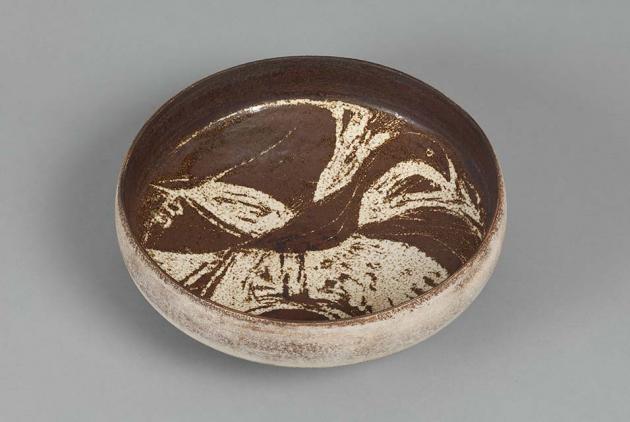An important ceramic bowl by the iconic German born British potter Hans Coper (1920 – 1981) has been saved for the nation. The announcement was made by the DCMS and the The Victoria and Albert Museum. Coper was arguably one of the most important post-war artist-potter. Made in London around 1955, this exceptional work was subject to a temporary export ban in 2015 and has now been saved for the nation. The large bowl, which reflects the artist’s dual interest in modern painting and ancient art, is now on display in the V&A’s Ceramics Galleries, close to the original potter’s wheel on which it was thrown. It was purchased in memory of the journalist Annabel Freyberg through the generosity of her friends, with remaining contributions from the V&A.
Coper created only a handful of large decorative bowls between about 1953 and 1955. Of these, the newly acquired bowl is a magnificent example. Depicting a bird with outstretched wings (perhaps a phoenix) above a sun-like motif, its powerful, simplified design contributes to the bowl’s primal character. Coper’s work of the 1950s, made before the sculptural forms for which he is better known, is comparatively rare in public collections today. The V&A has collected Coper’s ceramics since 1951 and has one of the most important public collections of his work. This stunning bowl joins 12 other examples in the Museum’s collection that trace the artist’s career over three decades.
Alun Graves, Senior Curator of Ceramics at the V&A, said: “The bowl is a stellar early work from one of the greatest ceramic artists of the last century. It is a rare example that captures through its bold figurative design a lesser-known aspect of Coper’s practice. I am delighted that it has been saved for the nation with the generous support of the friends of Annabel Freyberg.”
Hans Coper arrived in Britain 1939 and was interred as an ‘enemy alien’ with foreign nationals. During World War II he was posted to Canada on military service. On his return to London in 1946, he found work with Austrian potter and fellow émigré, Lucie Rie (1902 – 1995). With Rie’s support, he learnt to pot, initially as her apprentice, but soon producing his own work in her studio in Paddington, which they shared until 1958. Coper was instrumental to the development of studio pottery, a field of the visual arts in which Britain has played a leading role. Together with Rie, he brought a modern European sensibility to post-war British ceramics, rejecting the ruralism and Orientalism of others in the movement. Coper created works rich in sculptural expression, working with self-imposed discipline and a restricted range of materials and processes.
Artist Edmund de Waal, said: “Hans Coper’s pots have enormous presence. They seem to be of a continuum with the oldest vessels of history and yet completely contemporary. This magnificent bowl will be a wonderful addition to the greatest ceramics collection in the world.”
Valerian Freyberg, brother of Annabel Freyberg, said: “Annabel was a great admirer of Hans Coper’s work, as her book, Ceramics in the Home (1999) made clear. We are delighted that the V&A has been able to acquire such a significant piece in her name. It is also entirely appropriate that this memorial should be in the V&A, a museum she absolutely loved and that she visited often”.

